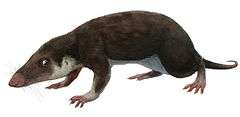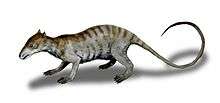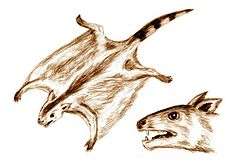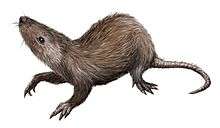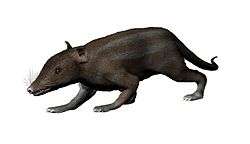Ausktribosphenidae
Ausktribosphenidae is a family of mammals from the Early Cretaceous of Australia that are closely related to monotremes.
| Ausktribosphenidae Temporal range: Early Cretaceous | |
|---|---|
| Scientific classification | |
| Kingdom: | Animalia |
| Phylum: | Chordata |
| Class: | Mammalia |
| Infraclass: | Australosphenida |
| Family: | †Ausktribosphenidae Rich et al., 1997[1] |
| Genera | |
Classification and taxonomy
Ausktribosphenidae is closely related to monotremes and hence the two form the yinotherian clade Australosphenida. It includes two species, Ausktribosphenos nyktos and Bishops whitmorei, both of which are known only from skull and jaw fragments.[2]
Morphology
Like other Australosphenida, ausktribosphenids have tribosphenic molars.
Distribution
Given that Ausktribosphenidae has been found in Early Cretaceous deposits in Australia, its occurrence has ramifications for knowledge of early monotreme paleobiogeography because Australia was connected only to Antarctica, and placentals originated in the northern hemisphere and were confined to it until continental drift formed land connections from North America to South America, from Asia to Africa and from Asia to India. The late Cretaceous map[3] shows how the southern continents are separated. However, the cladistic analysis of Cifelliodon recovers Fruitafossor as a monotreme relative, suggesting that yinotherians may have originated in the Northern Hemisphere.[4]
References
- Rich, Thomas H.; Vickers-Rich, Patricia; Constantine, Andrew; Flannery, Timothy F.; Kool, Lesley; van Klaveren, Nicholas (1997). "A Tribosphenic Mammal from the Mesozoic of Australia". Science. 278 (5342): 1438–1442. doi:10.1126/science.278.5342.1438. JSTOR 2894756.
- "Mammalia - Palaeos". Archived from the original on 2007-04-12.
- Christopher R. Scotese. "New Oceans Begin to Open". Paleomap project. Retrieved 20 September 2010.
- Adam K. Huttenlocker; David M. Grossnickle; James I. Kirkland; Julia A. Schultz; Zhe-Xi Luo (2018). "Late-surviving stem mammal links the lowermost Cretaceous of North America and Gondwana". Nature. in press. doi:10.1038/s41586-018-0126-y.
